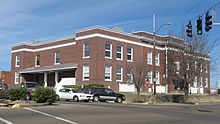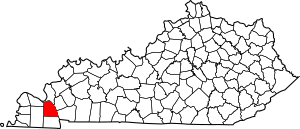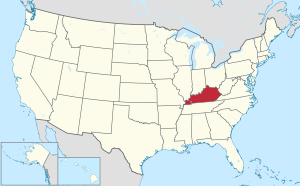Marshall County, Kentucky facts for kids
Quick facts for kids
Marshall County
|
|||
|---|---|---|---|

Marshall County Courthouse in Benton, Kentucky.
|
|||
|
|||

Location within the U.S. state of Kentucky
|
|||
 Kentucky's location within the U.S. |
|||
| Country | |||
| State | |||
| Founded | 1842 | ||
| Named for | John Marshall | ||
| Seat | Benton | ||
| Largest city | Benton | ||
| Area | |||
| • Total | 340 sq mi (900 km2) | ||
| • Land | 301 sq mi (780 km2) | ||
| • Water | 39 sq mi (100 km2) 11% | ||
| Population
(2020)
|
|||
| • Total | 31,659 | ||
| • Estimate
(2023)
|
31,744 |
||
| • Density | 93.1/sq mi (36.0/km2) | ||
| Time zone | UTC−6 (Central) | ||
| • Summer (DST) | UTC−5 (CDT) | ||
| Congressional district | 1st | ||
Marshall County is a place in western Kentucky, USA. It's a type of local government area called a county. In 2020, about 31,659 people lived here. The main town, or county seat, is Benton.
Marshall County is special because it's the only county in the Jackson Purchase area that doesn't touch another state. A small piece of land in Livingston County separates it from the Ohio River and the border with Illinois. For a long time, until 2015, it was a "dry county." This meant you couldn't buy alcohol in stores. But now, people can buy alcohol for home use, making it a "wet" county.
Contents
History of Marshall County
Marshall County was created in 1842. The Kentucky government decided to form it from the northern part of Calloway County. This happened because more and more people were moving to the area.
The first European-American settlers arrived around 1818. This was soon after the land was bought from the Chickasaw Native American people. This land deal was part of the Jackson Purchase. General Andrew Jackson and Kentucky Governor Isaac Shelby made this purchase. Sadly, the Chickasaw people were later forced to move to new lands far away.
Marshall County was named after John Marshall. He was a very important judge, the Chief Justice of the U.S. Supreme Court. He passed away in 1835.
Marshall County and the Civil War
During the American Civil War, Kentucky tried to stay neutral. However, Marshall County had strong ties to the Southern states. Many people here supported the Confederate side. Lots of local men joined the famous Kentucky Orphan Brigade.
In 1864, there was a small fight near Benton. Confederate soldiers led by General Nathan Bedford Forrest met Union cavalry. Both sides were looking for horses for their soldiers. Today, a special marker stands at this spot to remember the event.
Changes from Farming to Tourism
For many years, Marshall County was mostly about farming. But in the 1940s, things changed a lot. The Tennessee Valley Authority (TVA) built Kentucky Lake. The TVA was a government project to control floods and bring electricity to rural areas. This project was started by President Franklin D. Roosevelt.
Kentucky Lake brought tourism to the county. People started building resorts along the lake. These resorts were popular for sports fishing. The lake also provided cheap electricity from Kentucky Dam. This attracted chemical and manufacturing factories, especially near Calvert City.
Building the lake also meant that two old towns were flooded. These were Birmingham and Gilbertsville. People living there had to move out. Gilbertsville was rebuilt in a new spot, but Birmingham residents had to find new homes elsewhere. Kentucky Lake and Lake Barkley are connected by a canal. Together, they form one of the biggest man-made lakes in the world.
Geography
Marshall County covers about 340 square miles. Most of this area, 301 square miles, is land. The rest, about 39 square miles (11%), is water. The northeastern border of the county is formed by the Tennessee River and Kentucky Lake.
Neighboring Counties
Marshall County shares borders with several other counties:
- Livingston County (north)
- Lyon County (east)
- Trigg County (east)
- Calloway County (south)
- Graves County (west)
- McCracken County (west)
Protected Natural Areas
Part of the Clarks River National Wildlife Refuge is located in Marshall County. This is a special area set aside to protect wildlife.
Population Information
| Historical population | |||
|---|---|---|---|
| Census | Pop. | %± | |
| 1850 | 5,269 | — | |
| 1860 | 6,982 | 32.5% | |
| 1870 | 9,455 | 35.4% | |
| 1880 | 9,647 | 2.0% | |
| 1890 | 11,287 | 17.0% | |
| 1900 | 13,692 | 21.3% | |
| 1910 | 15,771 | 15.2% | |
| 1920 | 15,215 | −3.5% | |
| 1930 | 12,889 | −15.3% | |
| 1940 | 16,602 | 28.8% | |
| 1950 | 13,387 | −19.4% | |
| 1960 | 16,736 | 25.0% | |
| 1970 | 20,381 | 21.8% | |
| 1980 | 25,637 | 25.8% | |
| 1990 | 27,205 | 6.1% | |
| 2000 | 30,125 | 10.7% | |
| 2010 | 31,448 | 4.4% | |
| 2020 | 31,659 | 0.7% | |
| 2023 (est.) | 31,744 | 0.9% | |
| U.S. Decennial Census 1790–1960 1900–1990 1990–2000 2010–2020 |
|||
In 2000, about 30,125 people lived in Marshall County. Most people (over 98%) were White. A small number were Black, Native American, or Asian. About 0.76% of the population were Hispanic or Latino.
The average age of people in the county was 41 years old. About 21.8% of the population was under 18. About 17.5% of people were 65 or older.
Towns and Communities
Marshall County has several towns and smaller communities.
Cities
- Benton (This is the county seat, the main town for government.)
- Calvert City
- Hardin
Census-designated place
- Gilbertsville (This is a community that the U.S. Census Bureau defines for statistics.)
Other Communities
- Aurora
- Big Bear Area
- Brewers
- Briensburg
- Draffenville
- Fairdealing
- Harvey
- Moors Camp Area
- Oak Level
- Olive
- Palma
- Possum Trot
- Sharpe
- Tatumsville
Old Town
- Birmingham (This is a "ghost town" because it was flooded by Kentucky Lake.)
Fun Annual Events
Marshall County hosts some unique yearly events.
Tater Day
On the first Monday of April, Benton celebrates Tater Day. This event started in 1842. Back then, farmers would gather to trade their crops, especially sweet potatoes. Today, it's a big festival with a parade. The name "Tater Day" comes from trading sweet potatoes for planting.
The Big Singing
On the fourth Sunday of May, people gather for The Big Singing. This is an all-day event where everyone sings gospel music. They use a special type of music notation called shape note. The Big Singing started in 1884. It's famous because it's one of the only regular events that still uses the old Southern Harmony songbook.
Attractions and Other Fun Facts
Marshall County has some interesting places to visit.
Calvert Drive In Theater
This is the only drive-in movie theater in the Purchase area. It's one of only a few in western Kentucky. You can watch movies from your car, just like in the old days!
Silver Trail Distillery
This distillery makes a special drink called LBL Moonshine. The name comes from the "Land Between the Rivers," which is now the Land Between the Lakes. The distillery and a museum are in Hardin and Aurora. It's based on an old family story about making moonshine.
Mike Miller County Park
Marshall County is home to a large and complete park. It has baseball fields, basketball courts, soccer fields, and tennis courts. There's also a fishing pond, a big playground, and a spray park. The park was built on land given by a family. They donated it to remember their son who died in the Vietnam War.
FLW Bass Tournament
Marshall County is also home to the FLW Bass Tournament organization. FLW stands for Forrest L. Wood, who started Ranger Boats. This group organizes some of the biggest fishing tournaments in America. These include the FLW Tour and other events for college and high school fishing teams.
Notable People from Marshall County
Some famous people have come from Marshall County:
- Joe Creason – A well-known reporter and writer for the Louisville Courier Journal newspaper.
- J. J. Edens - Served in the Washington State Senate from 1889 to 1895.
- Robert H. Grubbs - Won the Nobel Prize in Chemistry in 2005.
- Terrina Chrishell Stause - An American actress. She is known for her roles on TV shows like All My Children and Days of Our Lives. She is also on the reality show Selling Sunset.
Images for kids
See also
 In Spanish: Condado de Marshall (Kentucky) para niños
In Spanish: Condado de Marshall (Kentucky) para niños






